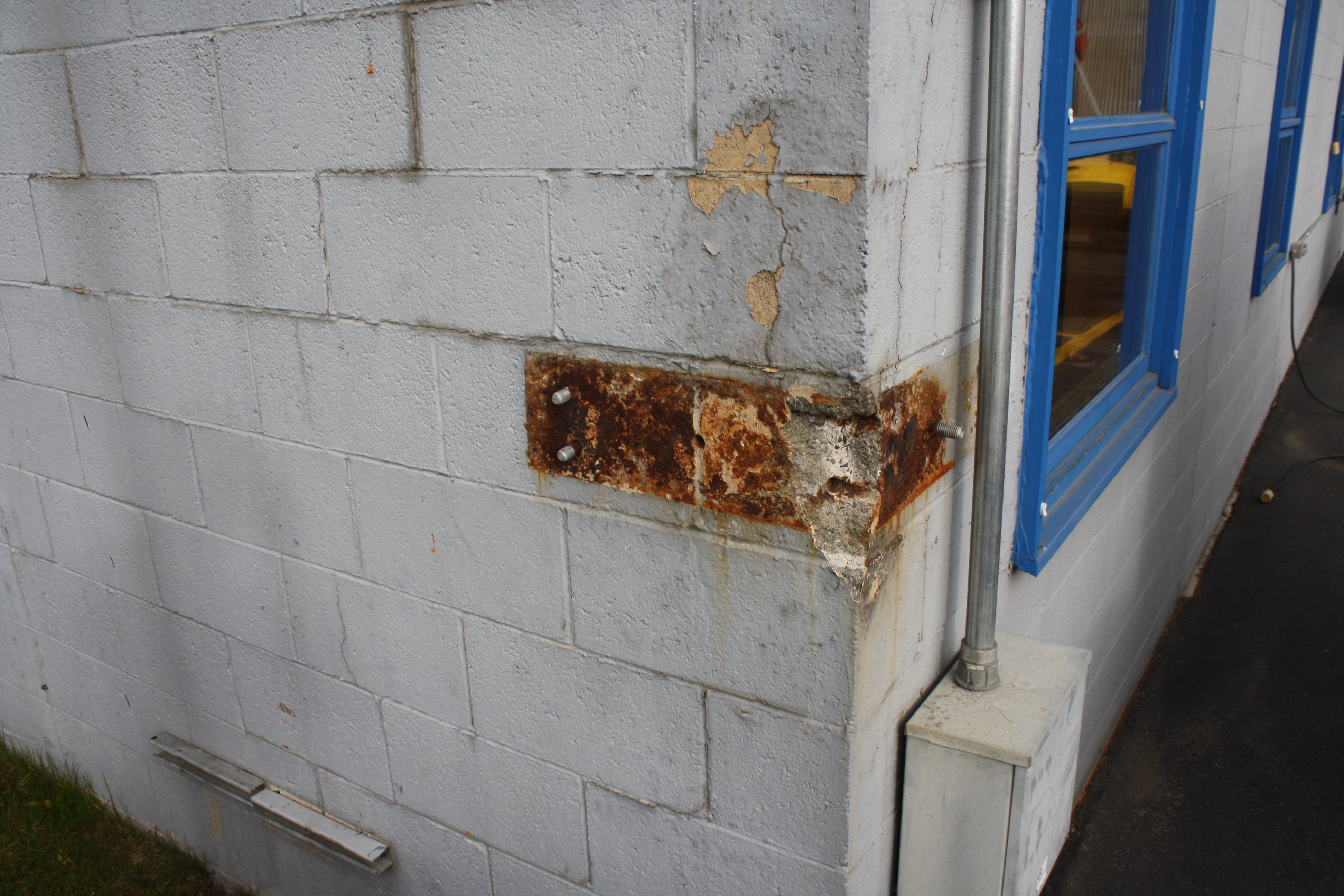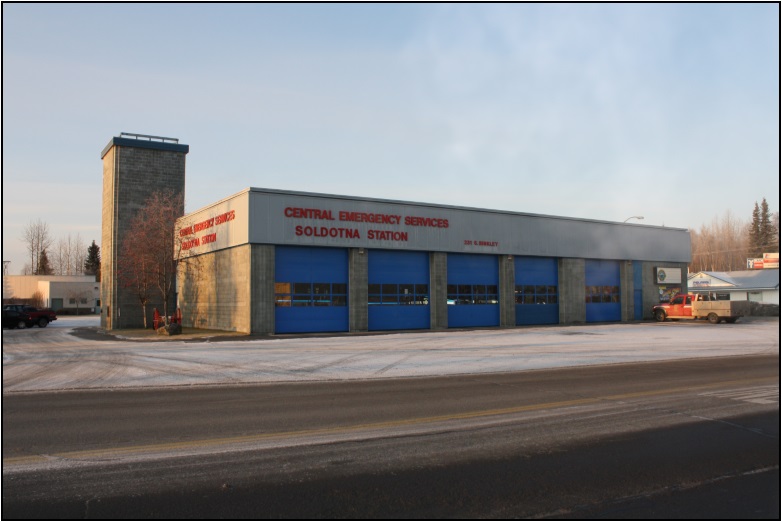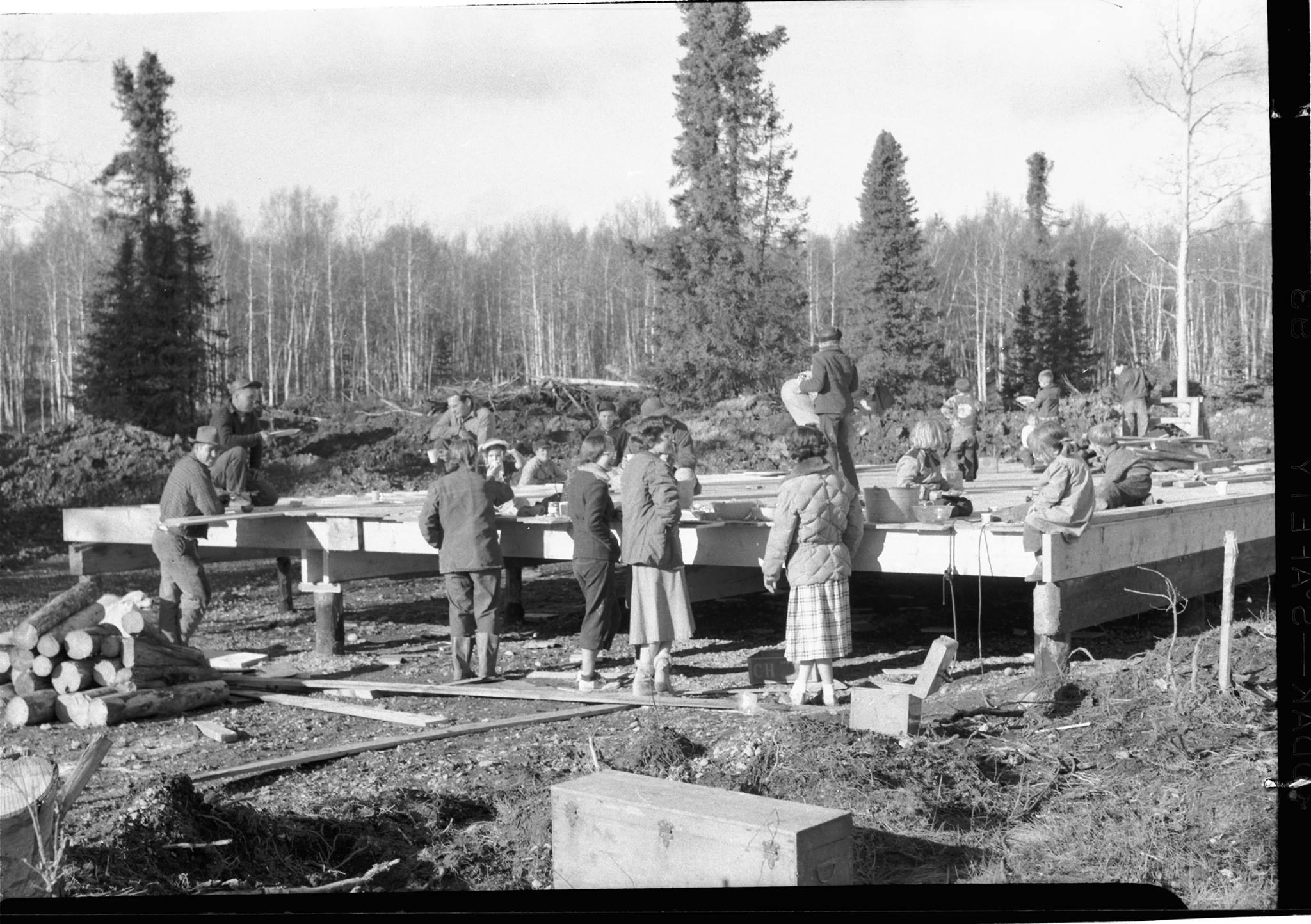CES Station 1 Project

Background
Central Emergency Services Station #1 is the primary response location for all of Soldotna. It also provides secondary coverage for the entire service area. In addition, Station #1 is headquarters to the four CES substations that serve the unincorporated communities of Ridgeway, Sterling, Kalifornsky, Kasilof, and Funny River.
CES station #1 is the busiest fire station on the Kenai Peninsula, providing over 3,000 responses annually to over 25,000 residents not including the summer influx of visitors to state and national forests. It also provides emergency response services on the Kenai and Kasilof Rivers, and supports emergency responses with neighboring emergency service areas. Additionally, CES supports Wildland fire operations to the Alaska Division of Forestry and provides auto-aid to the City of Kenai.
The original building was constructed in 1956 as a community hall. Sometime between 1964-1967 an addition was included to serve the volunteer fire department. A major remodel was completed in 1973 and the latest expansion to it's current size was in 1983.
The current facility has major deficiencies and damages that require significant repairs and improvements. This includes structural repairs, and increased square footage to support equipment and supply storage needs.
Needs & Purpose
- Station 1 does not have enough storage or space for the operational and logistical needs of our department:
- Storage in Station 1 is not sufficient for the station itself , but is utilized to house the medical supplies and equipment for all CES fire stations.
- The living space is limited for first responders. Quarters are cramped, and female responders do not have alternate living or changing areas.
- Station #1 was designed for a call volume of 300-400 calls for service per year. The current call volume is now over 3,000 responses per year. 70% of those responses are from Station #1. The need for ambulance and fire response vehicles has exceeded the ability to adequately store and house the vehicles. As a result, the vehicles are spread throughout the CES response area, extending response times or reducing life of equipment through housing items outdoors.
- Training space is insufficient for the continuing educational needs of its first responders.
- Space has to be rented on an on-going basis to ensure training requirements are met.
- There is no public meeting space.
- The current station does not allow for public meetings due to lack of space.
- The facility requires significant structural repairs that are costly.
1964: Volunteers constructing original living quarters. Still in use today.
Summary
- Service areas needs have outgrown the current Station 1 and its capability for expansion. Despite additions in 1973 and 1984, the current site and building have reached their maximum potential.
- CES Station #1 is a primary or secondary station for over 70% of all calls. An emergency call in your area, even if another CES staffed fire station is near you, will often require additional response equipment/vehicles which is dependent on CES Station#1’s ability to respond.
- A site has been identified and land has been procured to start building the station.
- The estimated cost is $16.5 Million, however, the hope is to build the facility for less than this amount.
- The estimated construction phase is expected to take approximately 24+ months.
 |
 |
 |
FUNDS & BOND MEASURE
|
PROPOSED
|
DESIGN DESCRIPTION
|
BENCHMARKS
|

Answers to Common Questions about Central Emergency Services Fire Station #1 Construction Project
What is a bond?
A bond is a financial tool that government agencies use to raise funds for long-term capital assets. The Borough defines “long- term” as having a lifespan of 20 years or more (buildings, for example). The bonding process requires voter approval in the State of Alaska.
Why use bonds instead of other funding methods?
Bonds provide funding at low interest rates (low cost of money). Bonds also allow debt issuance at the time they are needed; therefore, issuances can be planned to coincide with anticipated growth and development. This means residents only pay for the capital projects when (and if) bonds are issued.
What will the bond do for the Central Emergency Services Fire Service Area?
The capital projects associated with this ballot measure includes the relocation and construction of fire station #1. This facility will serve as the primary response station for the Soldotna area, and back-up to the other CES stations. It will also be the headquarters and warehouse for the smaller fire stations in the CES Service Area. This new CES facility will replace the existing station that is undersized for the current and future needs.
What amount is Central Emergency Services asking for in the upcoming election?
The total bond package of Central Emergency Services Fire Station #1 Construction Project is $16.5 million. This cost will include land preparation, design and engineering, and construction phase.
If approved, does the entire bond capacity of $16.5M have to be utilized?
No. If the anticipated growth and development does not occur, the Kenai Peninsula Borough is not obligated to issue all the bonds.
How much will the bond cost the average taxpayer?
Assuming the entire bond measure is utilized ($16.5M), the tax impact of this bond measure is about a .36 mill rate increase, or $36 dollars on $100,000 of property value.
Has any money been set aside for the project?
$900,000 was approved by the CES Service Area Board and Borough Assembly in July 2019 for the land acquisition purchase. $1M was approved by the CES Service Area Board and Borough Assembly in July 2021 for design and construction of the Station #1 relocation.
Doesn’t Station #1 just serve the City of Soldotna?
No. While Station #1 is the primary response location for the City of Soldotna, it extends to Mile 104 Sterling highway to the south, to Murwood Dr. on K-Beach Rd. and Forest Ln towards Sterling. It is also the headquarters to four CES substations that serve the unincorporated communities of Ridgeway, Sterling, Kalifornsky, Kasilof, Clam Gulch and Funny River. Meeting the service area needs for ~25,000 residents, not including the summer influx of visitors to state and national forests as well as providing emergency response services on the Kenai and Kasilof Rivers. It is the busiest fire station on the Kenai Peninsula, providing ~3,000 responses annually. Additionally, CES supports wildland fire operations to the Alaska Division of Forestry and provides auto-aid to the City of Kenai.
Has Central Emergency Services managed a bond measure in the past?
Yes. The service area voters approved a $4.4M bond in 2016.
What did Central Emergency Services 2016 bond measure cover?
The 2016 bond measure allowed for additions to our fire truck and ambulance fleet. The bonds authorized in this measure have been fully utilized.
How do I know the money will be spent as indicated?
Alaska law requires the Borough to identify what the bond money will be allocated for in the ballot measure. The Borough is required to comply with the ballot or be in violation of Alaska State Law. As with the 2016 bond package, the Borough and CES will provide public updates on the status of the bond funds at monthly Service Area board meetings. Bond monies are held in custody by the lending bond bank and all expenditures are subject to a review and approval process to ensure they meet bond criteria.
Where will you build the new Station #1?
The expected site will be on multiple parcels of land located at the corner of Wilson Lane and Warehouse Drive, in Soldotna. Those properties are adjacent to the current Office of Emergency Management building at 253 Wilson Lane.
When will the new station be completed?
The estimated construction phases are expected to take between 24-48 months, which is based upon having total funding in hand.
What Ballot Measure number will show up on my ballot that represents Central Emergency Services Fire Station #1 Construction bond?
Proposition #3 Central Emergency Service Area Station Bonds and Approval of Project
Why doesn’t the ballot simply say Central Emergency Services bond proposition?
Each ballot measure is assigned a number. This is the system that the Kenai Peninsula Borough utilizes in managing elections.
What will happen to the current Fire Station if the bond passes?
The current station would be part of the borough surplus process. Since the proposed new station will be designed to combine three facilities into one facility, the current station would no longer be required. Administrative Headquarters, Fire Station and Training room will be located in one building for more cost effective operations, saving money.


